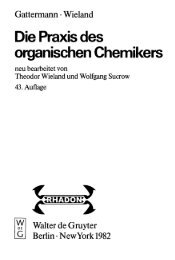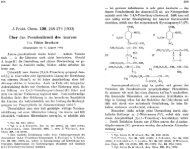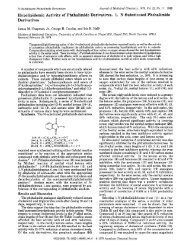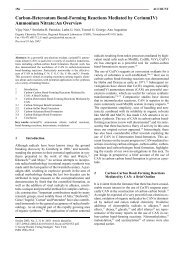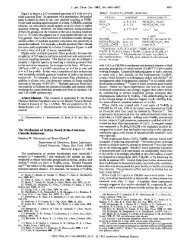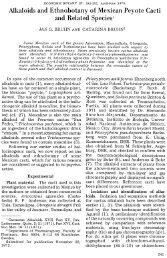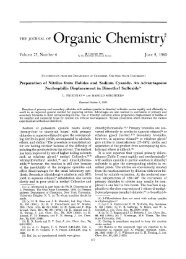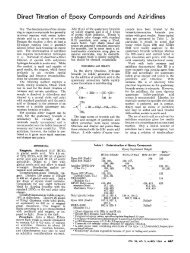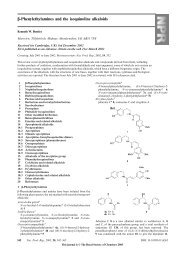Create successful ePaper yourself
Turn your PDF publications into a flip-book with our unique Google optimized e-Paper software.
A <strong>neo</strong>lignan-type impurity arising from the <strong>peracid</strong> oxidation<br />
reaction of <strong>anethole</strong> in the surreptitious synthesis of<br />
4-methoxyamphetamine (PMA)<br />
Abstract<br />
Dieter Waumans, Bas Hermans, Noël Bruneel, Jan Tytgat *<br />
Laboratory of Toxicology, Eduard van Evenstraat 4, 3000 Leuven, Belgium<br />
Received 20 November 2003; accepted 2 February 2004<br />
Available online 24 May 2004<br />
The <strong>neo</strong>lignan-type substance 2,4-dimethyl-3,5-bis(4’-methoxyphenyl) tetrahydrofuran is presented as a new forensic marker<br />
compound for the <strong>peracid</strong> oxidation of <strong>anethole</strong>. It is hypothesized that the formation of a stable intermediary carbocation in<br />
the hydrolysis reaction of <strong>anethole</strong> epoxide is not only responsible for the presence of 1,2-diols (and its esters) and<br />
4-methoxyphenyl-2-propanone (PMP2P) but can also be the cause for the creation of this <strong>neo</strong>lignan impurity due to interaction<br />
with <strong>anethole</strong> itself. Moreover, the applicability of this new forensic marker is demonstrated by its retrieval in clandestinely<br />
manufactured 4-methoxyamphetamine (PMA) preparations.<br />
# 2004 Elsevier Ireland Ltd. All rights reserved.<br />
Keywords: 2,4-dimethyl-3,5-bis(4’-methoxyphenyl) tetrahydrofuran; Anethole; Anise oil; Impurity profiling; Peracid oxidation<br />
1. Introduction<br />
Forensic Science International 143 (2004) 133–139<br />
The prospecting for synthesis impurities in illicitly<br />
produced drugs is one of the mainstays of forensic chemistry.<br />
It is an established fact that so-called impurity profiles can<br />
aid in the elucidation of the followed synthetic route and can<br />
be adopted in gaining information regarding underground<br />
distribution networks [1,2]. Hitherto, the majority of published<br />
scientific articles dealing with the topic discuss<br />
illicitly produced amphetamine, methamphetamine, 3,4methylenedioxyamphetamine<br />
(MDA) and 3,4-methylenedioxymethamphetamine<br />
(MDMA), in which the emphasis<br />
usually is on the Birch reduction [3], LiAlH4 reduction of<br />
nitrostyrene derivatives [4], the Leuckart reaction and/or<br />
other reductive amination procedures [5]. A recent surge in<br />
the incidence of 4-methoxyamphetamine (PMA) on the<br />
underground drug market necessitated the study of the<br />
impurities concomitantly formed during the surreptitious<br />
*<br />
Corresponding author Tel.:þ32-1632-3402;<br />
fax:þ32-1632-3405.<br />
E-mail address: jan.tytgat@pharm.kuleuven.ac.be (J. Tytgat).<br />
0379-0738/$ – see front matter # 2004 Elsevier Ireland Ltd. All rights reserved.<br />
doi:10.1016/j.forsciint.2004.02.033<br />
synthesis of this drug as well. Blachut et al. [6,7], Kirkbride<br />
et al. [8] and Coumbaros et al. [9] have recently contributed<br />
to the structural elucidation of Leuckart-specific PMA contaminants.<br />
Our research group has demonstrated that <strong>anethole</strong>,<br />
a major compound in (star) anise oil, can be used as<br />
precursor for 4-methoxyphenyl-2-propanone (PMP2P),<br />
which will yield PMA via the Leuckart reaction [10].<br />
Furthermore, it was also specified how 4-methoxyphenol<br />
was formed as specific impurity during the <strong>peracid</strong> oxidation<br />
of <strong>anethole</strong>.<br />
The current report describes the occurrence of an unexpected<br />
<strong>neo</strong>lignan-type impurity, viz. 2,4-dimethyl-3,<br />
5-bis(4’-methoxyphenyl) tetrahydrofuran (1). This impurity<br />
is formed during the peroxidation reaction step of<br />
<strong>anethole</strong> and has been communicated in the past regarding<br />
contaminants found in the industrial peroxidation reaction<br />
of <strong>anethole</strong> [11]. This intriguing impurity displays<br />
structural similarities with <strong>neo</strong>lignans occurring in<br />
nature, e.g. magnosalicin (and its diastereomers) (2)<br />
[12]. However, (1) has hitherto been unnoticed as potential<br />
forensic marker. We have examined its presence by<br />
conducting a series of experiments involving different<br />
reaction conditions, and have compared our laboratory
134 D. Waumans et al. / Forensic Science International 143 (2004) 133–139<br />
results with impurity profiles obtained from seized PMA<br />
preparations.<br />
2. Methods and techniques<br />
2.1. Chemicals and reagents<br />
All solvents used in this work were of analytical grade and<br />
purchased from Acros Organics (Geel, Belgium). Anise oil<br />
(China, derived from Illicium verum) was obtained from<br />
Taiga International NV (Breendonk-Puurs, Belgium). All<br />
other reagents had been acquired from Merck (Darmstadt,<br />
Germany).<br />
2.2. Instrumentation<br />
Sample analysis was effected with gas chromatography–<br />
mass spectrometry (GC/MS), viz. an Agilent 6890 Plus gas<br />
chromatograph equipped with an Agilent 5973N mass<br />
selective detector (MSD) and electronic pressure programming.<br />
Helium was used as a carrier gas at a constant<br />
linear flow rate of 1.0 mL/min; the column was a<br />
30 m 0:250 mm 0:25 mm VF-5 MS factorFour capillary.<br />
The mass spectrometer operated from 36 to 400 amu in<br />
electron impact (EI) mode with an ionization energy of<br />
70 eV. A solvent delay of 4.00 min was applied. Two<br />
different oven temperature programs and injection modes<br />
were used. Reaction mixtures: 1 mL injection (split 1:50),<br />
oven programming: 50 8C (held for 1 min), 35 8C/min to<br />
100 8C, 10 8C/min to 270 8C (held for 5 min). Seized sample<br />
screening: 1 mL injection (split 1:10), 50 8C (held for 1 min),<br />
5 8C/min to 270 8C.<br />
2.3. Synthesis procedures<br />
2.3.1. Preparation of performic and peracetic acid<br />
Performic acid was prepared by adding 6.8 g freezer-cold<br />
30% hydrogen peroxide to 24.0 g formic acid (98–100%).<br />
This mixture is stirred for ca. 1 h before using it in further<br />
syntheses. Due to the instability of performic acid, the<br />
solution has to be prepared fresh for every experiment. A<br />
stock solution of peracetic acid was prepared by combining<br />
288.0 g of 30% hydrogen peroxide and 4.0 g concentrated<br />
sulfuric acid with 100.0 g glacial acetic acid. The reaction<br />
mixture was stored for 5 days in a dark and well-ventilated<br />
place, after which it was ready for use [13].<br />
2.3.2. Peracid oxidation of <strong>anethole</strong><br />
2.3.2.1. Peracid oxidation of <strong>anethole</strong> dissolved in acetone.<br />
A 250 mL round-bottomed flask was equipped with a magnetic<br />
stirbar and a thermometer, and charged with a solution<br />
of 6.0 g anise oil in 30 mL acetone. Performic acid solution<br />
was added at such a rate that the reaction mixture temperature<br />
did not exceed 38 8C. After addition of the whole<br />
performic acid solution, the reaction was allowed to continue<br />
for ca 12 h. The reaction mixture was poured in its equal<br />
volume of cold distilled water (dH2O) and extracted with<br />
2 50 of mL dichloromethane (DCM). The yellow organic<br />
phase was isolated and washed with 75 mL of dH2O, after<br />
which the organic phase was dried over Na2SO4. After<br />
evaporation of the solvent under reduced pressure, an aromatically<br />
scented yellow oil weighing 8.1 g remained.<br />
Peracetic acid: substituting performic acid for 25.5 g<br />
peracetic acid solution yielded 5.8 g of a yellow oil after<br />
a similar work-up.<br />
For both reaction mixtures, 100 mL of the oil was dissolved<br />
in 5 mL of methanol for further GC/MS analysis.<br />
2.3.2.2. Peracid oxidation of <strong>anethole</strong> dissolved in dichloromethane.<br />
A 250 mL round-bottomed flask was equipped<br />
with a magnetic stirbar and a thermometer, and charged with<br />
a solution of 6.0 g anise oil in 25 mL of DCM. Performic<br />
acid solution was added to the vigorously stirred reaction<br />
mixture at such a rate that the reaction mixture temperature<br />
did not exceed 38 8C. The reaction was allowed to continue<br />
another 12 h after addition of the final performic acid<br />
solution. Subsequently, the reaction mixture was carried<br />
over to a separation funnel and the organic layer isolated.<br />
The aqueous phase was extracted with 50 mL of DCM and<br />
thereupon discarded. The combined organic phases were<br />
washed with 3 50 mL of dH 2O, after which it was dried<br />
over Na2SO4. This yielded 5.8 g of a bordeaux red viscous<br />
oil<br />
Peracetic acid: substituting performic acid for 25.5 g<br />
peracetic acid yielded 4.9 g of a yellow oil after a similar<br />
work-up.<br />
For both reaction mixtures, 100 mL of the oil was dissolved<br />
in 5 mL of methanol for further GC/MS analysis.<br />
2.4. Extraction method<br />
An aliquot of a seized sample (100 mg for powder and<br />
capsule content, 75 mg for pulverized tablet) was dissolved<br />
in 5 mL of 0.1 M hydrochloric acid. The solution was<br />
extracted with 5 mL of DCM by mixing it thoroughly with<br />
a rotamix device for 20 min. The organic phase was isolated<br />
and dried over Na 2SO 4, which was rinsed with 1 mL of<br />
DCM. The solvent was evaporated under a beam of nitrogen<br />
gas and the residue reconstituted in 75 mL of MeOH for GC/<br />
MS analysis.<br />
3. Results and discussion<br />
3.1. 2,4-dimethyl-3,5-bis(4’-methoxyphenyl)<br />
tetrahydrofuran in the performic and peracetic acid<br />
oxidation reaction of <strong>anethole</strong><br />
The presence of (1) in four reaction mixtures has been<br />
evaluated: performic and peracetic acid have been chosen as
<strong>peracid</strong>s, while acetone and DCM have been utilized as<br />
solvent. These are the most trivial choices when it comes<br />
down to simulating the <strong>peracid</strong> oxidation of a propenylbenzene<br />
in clandestine laboratories. Experiments conducted in<br />
the past revealed that anise oil had been used as PMA<br />
precursor, i.e. applied without prior purification of <strong>anethole</strong><br />
by means of fractional distillation under reduced pressure.<br />
Hence, our choice for anise oil and not <strong>anethole</strong>. Moreover, it<br />
is known that anise oil has a very high <strong>anethole</strong> content [14].<br />
As a rule, anise oil consists for 80–90% of <strong>anethole</strong> (cis and<br />
trans isomers, (3a) and (3b), respectively; predominantly<br />
present as trans) and there usually is a small percentage of<br />
methyl chavicol ((3c), the allyl isomer of <strong>anethole</strong>) as well<br />
(Fig. 1).<br />
As can be seen in chromatograms [a] through [d] in Fig. 2,<br />
(1) is present in all four reaction mixtures after the described<br />
work-up. It was found that three chromatographic peaks<br />
have been retrieved for this <strong>neo</strong>lignan, representing three out<br />
of four theoretically possible diastereomers for (1). Chromatogram<br />
[e] in Fig. 2 is the extracted ion chromatogram for<br />
m/z 268 from chromatogram [a] and indicates the presence<br />
of three diastereomers. Its mass spectrum is shown in the<br />
same figure together with the four possible configurations.<br />
Previous works discuss the NMR spectra of these compounds<br />
[11,15]. It is interesting to note, however, that this<br />
<strong>neo</strong>lignan is also formed in vitro using performic acid and<br />
not alone with peracetic acid, as applied in these two<br />
references.<br />
3.2. Investigation of the formation of 2,4-dimethyl-3,<br />
5-bis(4’-methoxyphenyl) tetrahydrofuran<br />
O<br />
O<br />
The formation of this impurity is directly linked to the<br />
hydrolysis of <strong>anethole</strong> epoxide in the reaction mixture. As<br />
D. Waumans et al. / Forensic Science International 143 (2004) 133–139 135<br />
O<br />
O<br />
O<br />
O<br />
O<br />
(1) (2)<br />
O<br />
O O<br />
(3a) (3b) (3c)<br />
Fig. 1. Structural formulas: (1) 2,4-dimethyl-3,5-bis(4’-methoxyphenyl) tetrahydrofuran; (2) magnosalicin; (3a) cis-<strong>anethole</strong>; (3b) trans<strong>anethole</strong>;<br />
(3c) methyl chavicol.<br />
O<br />
O<br />
O<br />
shown in Fig. 2 and more detailed in Fig. 3, <strong>anethole</strong> is<br />
converted into its epoxide analogue by the applied <strong>peracid</strong><br />
(in the present case, this would be performic or peracetic<br />
acid; Fig. 3 step A). This epoxide is hydrolyzed to its 1,2diol<br />
analogue (step B) and is usually present as a formyl or<br />
acetyl derivative. By refluxing the 1,2-diol in a sulfuric acidmethanol<br />
mixture, it will be dehydrated to PMP2P (4) (step<br />
C, better known as the pinacol–pinacolone rearrangement).<br />
The latter can be used as precursor for PMA [6] (step G,by<br />
for instance the Leuckart reaction).<br />
However, <strong>anethole</strong> epoxide can convert into the stable<br />
carbocation (5) as well (Fig. 3 step D). The latter can be<br />
reacted to its corresponding 1,2-diol with water (step F) or<br />
can be converted into (4) by hydrogen migration when (5) is<br />
present as a zwitterion (step E). The <strong>anethole</strong> epoxide<br />
derived presence of (5) has been described by Mohan<br />
et al. [16,17], who trapped it by means of forming the azide<br />
analogue. Interestingly, we found (4) in all described test<br />
runs (i.e. prior to the pinacol–pinacolone rearrangement!).<br />
This presence can now be explained via the intermediary<br />
formation of (5) as well.<br />
The same carbocation (5) can be held responsible for the<br />
formation of (1). As shown in the reaction scheme in Fig. 2,<br />
<strong>anethole</strong> serves as precursor for both <strong>anethole</strong> epoxide (A)—<br />
and hence carbocation (5) (B)—as (1). Anethole and (5) will<br />
form an intermediary and unstable complex (C and D),<br />
which will be subject for an intramolecular rearrangement<br />
to yield (1) (E).<br />
3.3. Screening for 2,4-dimethyl-3,5-bis(4’-methoxyphenyl)<br />
tetrahydrofuran in clandestine PMA preparations<br />
A total of four different clandestine PMA preparations<br />
have been screened for the presence of (1). The
136 D. Waumans et al. / Forensic Science International 143 (2004) 133–139<br />
preparations have been confiscated by Belgian Law<br />
Enforcement in 2001/2002 and have been transferred to<br />
our laboratory for investigation. Previous findings<br />
have meanwhile entered the published scientific literature<br />
(a)<br />
(b)<br />
(c)<br />
(d)<br />
1<br />
1<br />
1<br />
1<br />
m/z 268<br />
5.00 10.00 15.00 20.00 25.00 30.00<br />
min<br />
[10]. The screened preparations include two brownish<br />
powders (seized from different sources), a capsule containing<br />
a similarly appearing brownish powder, and a<br />
beige tablet bearing an ‘xTc’-logo. The latter has been<br />
20.00 21.00 22.00 23.00 24.00 25.00<br />
Fig. 2. Chromatograms: [a] performic acid oxidation in acetone [b] performic acid oxidation in DCM [c] peracetic acid oxidation in acetone<br />
[d] peracetic acid oxidation in DCM [e] extracted ion chromatogram (m/z 268) for retention time interval 20.00–25.00 from [a]. Mass<br />
spectrum: The diastereomers have identical mass spectra. The four theoretically possible diastereomers are shown. Reaction scheme: Anethole<br />
is epoxidized (A), after which the obtained <strong>anethole</strong> epoxide is converted to a stable carbocation (5) (B). Formation of <strong>neo</strong>lignan (1) follows<br />
from the interaction between (5) and <strong>anethole</strong> (C), which results in the formation of an unstable intermediary product prone to intramolecular<br />
rearrangements (E).<br />
O<br />
(e)<br />
O<br />
O<br />
(1)<br />
O<br />
O<br />
B<br />
E<br />
O<br />
OH<br />
O<br />
A<br />
+<br />
(5)<br />
+<br />
min<br />
OH<br />
O<br />
O<br />
C<br />
D<br />
OH<br />
O<br />
+<br />
O
Abundance<br />
39<br />
65<br />
communicated in the past to have been involved in at least<br />
two lethal accidents in Belgium [18].<br />
The chromatographic results are shown in Fig. 4 and<br />
show the presence of (1) in all four samples, hereby<br />
indicating that they all have been manufactured in a similar<br />
way, viz. via <strong>peracid</strong> oxidation of <strong>anethole</strong>. Palmitic and<br />
stearic acid present in the tablet slightly interfere, but the<br />
extracted ion chromatogram for m/z 268 leaves little doubt<br />
(Fig. 4, chromatogram [e]). Furthermore, we found three<br />
A<br />
MeOPh<br />
MeOPh<br />
O O<br />
D. Waumans et al. / Forensic Science International 143 (2004) 133–139 137<br />
O<br />
77<br />
91<br />
PhOMe<br />
O PhOMe<br />
105<br />
121 145<br />
161<br />
176<br />
207 222<br />
195<br />
40 60 80 100 120 140 160 180 200 220 240 260 280 300<br />
O<br />
MeOPh<br />
MeOPh<br />
O<br />
PhOMe<br />
O PhOMe<br />
Fig. 2. (Continued ).<br />
O<br />
O<br />
OH<br />
237<br />
253<br />
268<br />
peaks for the different diastereomers in all screened samples;<br />
a similar finding has been reported earlier in this text for<br />
simulated experiments.<br />
Other distinctly present and previously described impurities<br />
are 4-methoxyphenol [10] (A) as <strong>anethole</strong> peroxidation<br />
marker, and 4-methyl-5-(4’-methoxyphenyl) pyrimidine [8]<br />
(C) as Leuckart reaction marker. The retrieval of 4-methoxyphenyl-2-propanol<br />
(B) points at the reduction of (4), which<br />
can occur during the Leuckart reaction as well [9].<br />
OH<br />
B C<br />
D +<br />
E<br />
F<br />
(5)<br />
Fig. 3. Anethole is reacted to its epoxide analogue using performic or peracetic acid (A). This epoxide is hydrolyzed to the vic-diol<br />
derivative (B), which in turn is dehydrated in a sulfuric acid-methanol mixture in a next synthesis step to yield 4-methoxyphenyl-2-propanone<br />
(4) (C). Anethole epoxide can also be converted to an intermediary carbocation (5) (D), which can be reacted with water to yield the vic-diol<br />
(F) or it can rearrange to (4) in its zwitterionic form (E). (4) can be subjected to e.g. the Leuckart reaction to obtain 4-methoxyamphetamine<br />
(PMA).<br />
OH<br />
O<br />
(4)<br />
O<br />
G<br />
312<br />
(1)<br />
m/z<br />
O<br />
NH 2
138 D. Waumans et al. / Forensic Science International 143 (2004) 133–139<br />
1.6E6<br />
1.2E6<br />
8.0E5<br />
4.0E5<br />
8.0E5<br />
6.0E5<br />
4.0E5<br />
2.0E5<br />
1.2E6<br />
1.0E6<br />
8.0E5<br />
6.0E5<br />
4.0E5<br />
2.0E5<br />
1.0E6<br />
8.0E5<br />
6.0E5<br />
4.0E5<br />
2.0E5<br />
(a)<br />
5.00 10.00 15.00 20.00 25.00 30.00 35.00 40.00<br />
(b)<br />
5.00 10.00 15.00 20.00 25.00 30.00 35.00 40.00<br />
(c)<br />
5.00 10.00 15.00 20.00 25.00 30.00 35.00 40.00<br />
(d)<br />
A<br />
A<br />
A<br />
A<br />
B<br />
B<br />
B<br />
B<br />
5.00 10.00 15.00 20.00 25.00 30.00 35.00 40.00<br />
C<br />
C<br />
C<br />
C<br />
1<br />
1<br />
1<br />
min<br />
min<br />
min<br />
min<br />
m/z 268<br />
(e)<br />
40.00 41.00 42.00<br />
min<br />
43.00<br />
Fig. 4. Chromatograms: [a] and [b] are both brownish powders, [c] is a brownish powder contained in a capsule and [d] is a tablet extract. [e]<br />
is the extracted ion chromatogram for m/z 268 for retention time interval 40.00–43.00 for [d].<br />
1
4. Conclusion<br />
It has been found that 2,4-dimethyl-3,5-bis(4’-methoxyphenyl)<br />
tetrahydrofuran, a chemical substance with a <strong>neo</strong>lignan<br />
structure, is formed during the performic and<br />
peracetic acid mediated oxidation of <strong>anethole</strong>. Taking into<br />
consideration the manner this impurity is formed during the<br />
reaction, it can be argued that this compound is a selective<br />
marker for the <strong>peracid</strong> oxidation reaction of <strong>anethole</strong>. Its<br />
applicability is demonstrated by its presence in clandestinely<br />
manufactured preparations. It should be noted, however, that<br />
the presence of this impurity depends on a great deal on the<br />
underground chemist’s work-up abilities and/or mindset.<br />
Since the new impurity is a high-boiling substance, it is<br />
unlikely to retrieve it if intermediary purification of PMP2P<br />
has occurred.<br />
Acknowledgements<br />
We would like to thank Miss Wendy Peeters for her<br />
contributions to this project.<br />
References<br />
D. Waumans et al. / Forensic Science International 143 (2004) 133–139 139<br />
[1] D.G. Sanger, I.J. Humpreys, A.C. Patel, M. Japp, R.G.L.<br />
Osborne, The significance of gas chromatographic impurity<br />
patterns obtained from illicitly produced amphetamine,<br />
Forensic Sci. Int. 28 (1985) 7–17.<br />
[2] W. Krawczyk, A. Parczewski, Application of chemometric<br />
methods in searching for illicit Leuckart amphetamine<br />
sources, Anal. Chim. Acta 446 (2001) 107–114.<br />
[3] K.L. Windahl, M.J. McTigue, J.R. Pearson, S.J. Pratt, J.E.<br />
Rowe, E.M. Sear, Investigation of the impurities found in<br />
methamphetamine synthesized from pseudoephedrine by<br />
reduction with hydroiodic acid and red phosphorus, Forensic<br />
Sci. Int. 76 (1995) 97–114.<br />
[4] J. DeRuiter, C.R. Clark, F.T. Noggle, Gas chromatographic<br />
and mass spectral analysis of amphetamine products synthesized<br />
from 1-phenyl-2-nitropropene, J. Chromat. Sci. 32<br />
(1994) 511–519.<br />
[5] A.M.A. Verweij, Clandestine manufacture of 3,4-methylenedioxymethylamphetamine<br />
(MDMA) by low pressure reductive<br />
amination. A mass spectrometric study of some reaction<br />
mixtures, Forensic Sci. Int. 45 (1990) 91–96.<br />
[6] D. Blachut, K. Wojtasiewicz, Z. Czarnocki, Identification and<br />
synthesis of some contaminants present in 4-methoxyamphetamine<br />
(PMA) prepared by the Leuckart method, Forensic<br />
Sci. Int. 127 (2003) 45–62.<br />
[7] D. Błachut, J.K. Maurin, K. Wojtasiewicz, W. Starosta, Z.<br />
Czarnocki, (2S)-1-(4-methoxyphenyl)-N-[(1R)-2-(4-methoxyphenyl)-1-methylethyl]-2-propanamine<br />
in crude p-methoxyamphetamine<br />
(PMA) produced by the Leuckart method, Z.<br />
Naturforsch. 57b (2002) 593–597.<br />
[8] K.P. Kirkbride, A.D. Ward, N.F. Jenkins, G. Klass, J.C.<br />
Coumbaros, Synthesis of 4-methyl-5-arylpyrimidines and 4arylpyrimidines:<br />
route specific markers for the Leuckardt<br />
preparation of amphetamine, 4-methoxyamphetamine, and 4methylthioamphetamine,<br />
Forensic Sci. Int. 115 (2001) 53–67.<br />
[9] J.C. Coumbaros, K.P. Kirkbride, G. Klass, Application of<br />
solid-phase microextraction to the profiling of an illicit drug:<br />
manufacturing impurities in illicit 4-methoxyamphetamine, J.<br />
Forensic Sci. 44 (6) (1999) 1237–1242.<br />
[10] D. Waumans, N. Bruneel, J. Tytgat, Anise oil as paramethoxyamphetamine<br />
(PMA) precursor, Forensic Sci. Int.<br />
133 (2003) 159–170.<br />
[11] H.-P. Schmauder, D. Gröger, D. Lohmann, H. Grüner, H.<br />
Foken, A. Zschunke, Über Nebenprodukte einer technischen<br />
Anetholoxidation, Pharmazie 34 (1979) 22–25.<br />
[12] M. De Fátima Da Silva, F.S.N. Taveira, J. Guiliierme Soares<br />
Maia, L.M. Conserva, M. Yoshida, O.R. Gottlieb, The natural<br />
occurrence of magnosalicin diastereomers, Phytochemistry 45<br />
(7) (1997) 1527–1528.<br />
[13] F.P. Greenspan, The convenient preparation of per-acids, J.<br />
Am. Chem. Soc. 68 (1946) 907.<br />
[14] E. Guenther, The essential oils, vol. IV (pp. 563-570), vol. IV<br />
(pp. 634-645) and Vol. V (pp. 361-379). D. Van Nostrand<br />
Company, New York 1950.<br />
[15] K. Mori, M. Komatsu, M. Kido, K. Nakagawa, A simple<br />
biogenetic-type synthesis of magnosalicin, a new <strong>neo</strong>lignan<br />
with antiallergy activity isolated from Magnolia salicifolia,<br />
Tetrahedron 42 (2) (1986) 523–528.<br />
[16] R.S. Mohan, D.L. Whalen, Acid-catalyzed hydrolysis of cisand<br />
trans-<strong>anethole</strong> oxides: discrete carbocation intermediates<br />
and syn/anti hydration ratios, J. Org. Chem. 58 (1993)<br />
2663–2669.<br />
[17] R.S. Mohan, K. Gavardinas, S. Kyere, D.L. Whalen, Sponta<strong>neo</strong>us<br />
hydrolysis reactions of cis- and trans-b-methyl-4methoxystyrene<br />
oxides (<strong>anethole</strong> oxides): buildup of trans<strong>anethole</strong><br />
oxide as an intermediate in the sponta<strong>neo</strong>us reaction of<br />
cis-<strong>anethole</strong> oxide, J. Org. Chem. 65 (2000) 1407–1413.<br />
[18] S. Voorspoels, V. Coucke, P. Schepens, Paramethoxyamphetamine:<br />
first fatalities in Belgium, Bull. Int. Assoc. Forensic<br />
Toxicol. 31 (4) (2002) 12–13.




